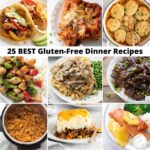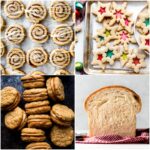Navigating the world of nut allergies with children can feel like a culinary tightrope walk. Fear not! This guide unveils a treasure trove of delicious, nut-free recipes that are not only allergy-safe but also guaranteed family favorites. We’ll explore diverse recipe categories, offering step-by-step instructions, ingredient substitutions, and even a week-long meal plan designed to simplify your life while ensuring everyone enjoys nutritious and flavorful meals.
From mastering the art of nut-free baking to confidently adapting existing recipes, we’ll equip you with the knowledge and confidence to create a vibrant and allergy-conscious kitchen. Discover the secrets to maintaining texture and flavor when swapping ingredients, learn how to read labels for potential cross-contamination, and engage your children in the fun of cooking and meal planning. This isn’t just about avoiding nuts; it’s about creating joyful family moments around the dinner table.
Nut-Free Recipe Categories
Finding delicious and safe meals for families with nut allergies can be a challenge, but with a little creativity, it’s entirely possible to create a diverse and exciting range of nut-free dishes everyone will enjoy. This section explores popular nut-free recipe categories, providing examples and emphasizing their suitability for families needing to avoid nuts.
Nut-Free Recipe Categories Table
Creating a diverse menu is key to ensuring everyone feels included and satisfied. The following table organizes popular nut-free recipe categories, highlighting examples and essential allergen considerations.
| Category | Description | Example Dish | Allergen Considerations |
|---|---|---|---|
| Pasta Dishes | Pasta dishes offer endless versatility and are generally nut-free. They’re easy to adapt to different tastes and dietary needs. | Creamy Tomato and Spinach Pasta | Ensure all ingredients, including pasta sauces and cheeses, are nut-free. Check labels carefully. |
| Chicken and Poultry Dishes | Chicken and poultry are lean protein sources that form the base of many family-friendly meals. They are naturally nut-free. | Roasted Lemon Herb Chicken with Roasted Vegetables | Be mindful of marinades or rubs, ensuring they are nut-free. Check all spice blends for potential cross-contamination. |
| Grain Bowls | Grain bowls offer a healthy and customizable meal option, allowing for a variety of flavors and textures without nuts. | Quinoa Bowl with Black Beans, Corn, and Avocado | Focus on using naturally nut-free grains and toppings. Avoid pre-made sauces or dressings that may contain hidden nuts. |
| Soups and Stews | Hearty soups and stews are perfect for cooler evenings and can be easily adapted to include a variety of vegetables and proteins. | Chicken Noodle Soup | Check all stock cubes and spice blends for hidden nuts or nut derivatives. Homemade broths are ideal for complete control. |
| Baked Goods (Nut-Free) | Many delicious baked goods can be made without nuts, using alternative ingredients like sunflower seeds or pumpkin seeds. | Banana Bread (with sunflower seeds) | Carefully read all ingredient labels and ensure your baking area is free from nut contamination. Use separate equipment. |
Detailed Descriptions of Nut-Free Recipe Categories
Providing detailed descriptions of each category will help families confidently navigate nut-free cooking.
Pasta Dishes: Imagine a vibrant plate of creamy tomato and spinach pasta, the sauce clinging to perfectly cooked pasta. The deep red of the tomatoes contrasts beautifully with the deep green of the spinach, creating a visually appealing dish. The creamy texture adds richness without relying on any nut-based ingredients. This dish is easily adaptable; you can substitute the spinach for other vegetables, add different cheeses, or change the sauce entirely. The key is using readily available, nut-free ingredients and ensuring all components are certified nut-free.
Chicken and Poultry Dishes: Picture a golden-brown roasted chicken, glistening with lemon herb juices, surrounded by colorful roasted vegetables. The vibrant colors of the vegetables – perhaps carrots, potatoes, and broccoli – complement the rich brown of the chicken. The aroma is both savory and bright, thanks to the lemon and herbs. The chicken itself is naturally nut-free, but attention must be paid to the marinade or rub used. Opt for simple herb blends or homemade marinades to ensure there’s no accidental nut contamination.
Grain Bowls: Visualize a colorful grain bowl brimming with textures and flavors. A base of fluffy quinoa is topped with vibrant black beans, sweet corn kernels, creamy avocado slices, and perhaps some chopped cilantro. The colors are bright and appealing, showcasing the natural hues of the ingredients. The textures vary from the soft quinoa to the firm beans and creamy avocado, creating a satisfying and balanced meal. The key to a successful grain bowl is using a variety of fresh, nut-free ingredients, creating a visually stunning and nutritionally complete meal.
Recipe Adaptation and Troubleshooting

Adapting recipes to be nut-free often presents unique challenges, requiring careful consideration of ingredient substitutions and adjustments to cooking methods. Successfully navigating these challenges results in delicious, allergy-safe meals the whole family can enjoy. Understanding the common pitfalls and employing effective troubleshooting strategies is key to consistent success.
Common Challenges in Nut-Free Recipe Adaptation
Many recipes rely on nuts for their flavor, texture, and binding properties. Replacing these components requires thoughtful substitution. For example, the rich, buttery flavor of nuts is difficult to perfectly replicate, and their ability to bind ingredients in baking can be challenging to replace. Similarly, the texture provided by nuts, whether it’s a crunchy element or a creamy consistency, needs to be carefully considered.
Ingredient Substitution and Cooking Adjustments
Successful nut-free baking and cooking hinge on understanding how different ingredients impact the final product. For example, substituting almond flour for all-purpose flour might require adjustments to liquid amounts, as almond flour absorbs more liquid. Sunflower seed butter can be a good substitute for peanut butter in some recipes, offering a similar creamy texture, but its flavor profile is subtly different. Similarly, using pumpkin seeds or pepitas instead of walnuts in a salad will change the texture and slightly alter the flavor. Adjusting cooking times and temperatures is often necessary. For instance, recipes using sunflower seed butter might require a slightly lower temperature to prevent burning, while those with heavier substitutes like chickpea flour might need a longer baking time to achieve the desired texture.
Troubleshooting Common Baking Issues
Understanding potential problems and their solutions is crucial for successful nut-free baking. A proactive approach helps avoid frustration and ensures consistently delicious results.
- Dry Baked Goods: This often occurs when substituting nut flours, which can absorb more moisture than all-purpose flour. Solution: Add 1-2 tablespoons of liquid at a time until the desired consistency is reached. Imagine a cake batter that’s too thick; adding a little milk or water, a spoonful at a time, will make it more pliable.
- Crumbly Texture: This can result from using too much of a dry ingredient, such as almond flour, or from insufficient binding agents. Solution: Increase the amount of binding agents like flaxseed meal or applesauce. Think of a cookie that crumbles easily; adding a little more binding agent, such as mashed banana, will help hold it together.
- Flat Baked Goods: Leavening agents might not be properly activated, or the batter might be too dense. Solution: Ensure your baking powder or baking soda is fresh and properly incorporated into the batter. Over-mixing can also deflate baked goods, so mix only until just combined. Visualize a pancake that’s thin and flat instead of fluffy; the leavening agents weren’t activated properly, or it was over-mixed.
- Burning: This is common when using ingredients with a higher fat content or when the oven temperature is too high. Solution: Reduce the oven temperature by 25°F (14°C) and monitor closely. Consider using a darker baking pan to absorb heat and distribute it more evenly. Picture a brownie that’s burnt on the edges but gooey in the middle; this indicates the oven temperature was too high.
Creating delicious and safe meals for your family, especially when navigating dietary restrictions, can be incredibly rewarding. This guide has provided you with the tools and resources to confidently craft nut-free meals that are both allergy-safe and family-approved. Remember, the journey to a nut-free kitchen is filled with exciting culinary adventures. Embrace the creativity, involve your family, and savor the delicious results – happy cooking!
Common Queries
What if my child has multiple allergies beyond nuts?
Always consult with an allergist or registered dietitian to create a personalized plan that addresses all your child’s specific allergies. They can help you identify safe ingredients and manage cross-contamination risks effectively.
Where can I find certified nut-free products?
Many brands clearly label their products as “nut-free” or “manufactured in a nut-free facility.” Look for certifications from reputable organizations, but always double-check ingredients lists to be absolutely certain.
How can I prevent cross-contamination in my kitchen?
Designate separate cutting boards, utensils, and cooking surfaces for nut-free foods. Thoroughly clean all surfaces and equipment after handling any products that contain nuts. Consider using separate storage containers for nut-free and nut-containing ingredients.
Are all nut-free substitutes nutritionally equivalent to their nut-based counterparts?
Not necessarily. Some substitutes may offer similar textures and flavors, but their nutritional profiles might differ. Pay attention to the nutritional information of the substitutes you choose and adjust your recipes accordingly.


